Jul 27 2018
A new image-based analysis method has been formulated by scientists at Binghamton University, State University at New York to identify formerly-hidden North American mounds, which could expose useful data about pre-contact Native Americans.
 Four shell ring features identified using the object-based image analysis (OBIA) algorithm. The ring on the top right has been confirmed as a shell ring site. (Image credit: Carl Lipo)
Four shell ring features identified using the object-based image analysis (OBIA) algorithm. The ring on the top right has been confirmed as a shell ring site. (Image credit: Carl Lipo)
Across the East Coast of the United States, some of the most visible forms for pre-contact Native American material culture can be found in the form of large earthen and shell mounds. Mounds and shell rings contain valuable information about the way in which past people lived in North America. As habitation sites, they can show us the kinds of foods that were eaten, the way in which the community lived, and how the community interacted with neighbors and their local environments.
Carl Lipo, Anthropologist at Binghamton University
In areas that are thickly wooded or comprise swamps and bayous, there exist mounds that have escaped nearly 150 years of archaeological survey and research. Owing to vegetation, these kinds of environments make it difficult to see beyond a couple of dozen feet, and even large mounds can be concealed from view, even if one methodically walks on the terrain.
The use of satellites and new varieties of aerial sensors such as light detection and ranging (LiDAR) have changed the way archaeologists can collect data about the archaeological record, said Lipo. Presently, researchers can examine landscapes from images and peer through the forest covering to view the ground. LiDAR has been principally effective at revealing the characteristic rises in topography that mark the existence of mounds. The challenge before archaeologists, however, is to handle such a massive array of new data that are available for analysis.
Object-based image analysis (OBIA) allows archaeologists to construct a program to automatically detect topographies of interest. OBIA is a computer-based approach that uses data from satellite images and aerial sensors to search for shapes and combinations of features that match objects of interest. In contrast to traditional satellite image analyses that focus on combinations of light wavelengths, OBIA includes characteristics of shape to the search algorithm, allowing archaeologists to more easily differentiate cultural from natural occurrences.
Lipo's team methodically identified more than 160 formerly undetected mound characteristics using LiDAR data from Beaufort County, S.C., and an OBIA approach. The result enhances the total knowledge of settlement patterns by providing organized knowledge about earlier landscapes, said Lipo.
"Through the use of OBIA, archaeologists can now repeatedly generate data about the archaeological record and find historic and pre-contact sites over massive areas that would be cost-prohibitive using pedestrian survey. We can now also peer beneath the dense canopy of trees to see things that are otherwise obscured. In areas like coast South Carolina, with large swaths of shallow bays, inlets, and bayous that are covered in forest, OBIA offers us our first look at this hidden landscape."
Having shown the effectiveness of using OBIA in conditions of thick vegetation and after enhancing their processing, Lipo and his team are expanding their work to incorporate much-larger areas.
"Fortunately, satellite and LiDAR data are now available for much of the eastern seaboard, so undertaking a large-scale project is now a task that is achievable," said Lipo. "Due to climate change and sea-level rise, many major mounds and middens on the East Coast are threatened by erosion and inundation. It is urgent we document this pre-contact landscape as soon as possible, in order to learn as much as we can about the past before it is gone forever."